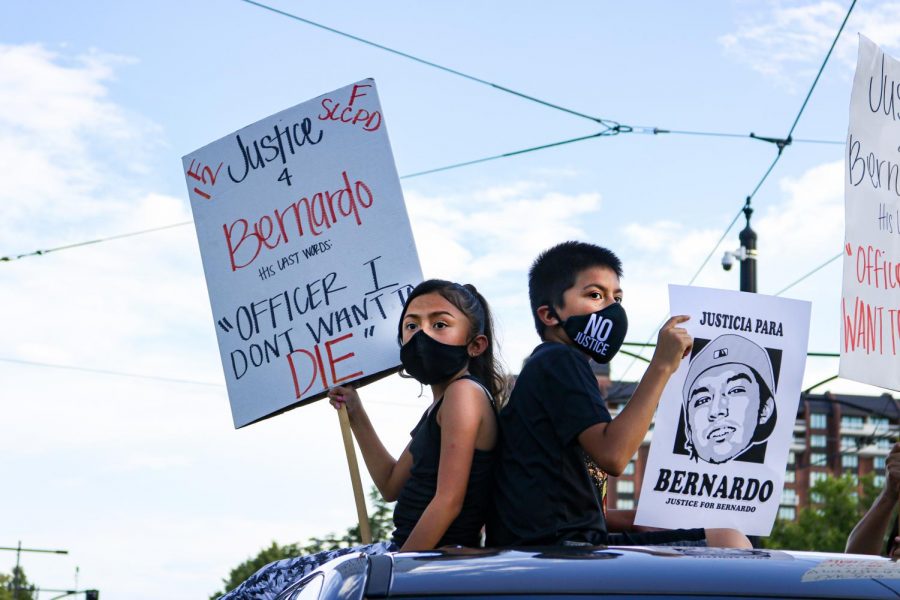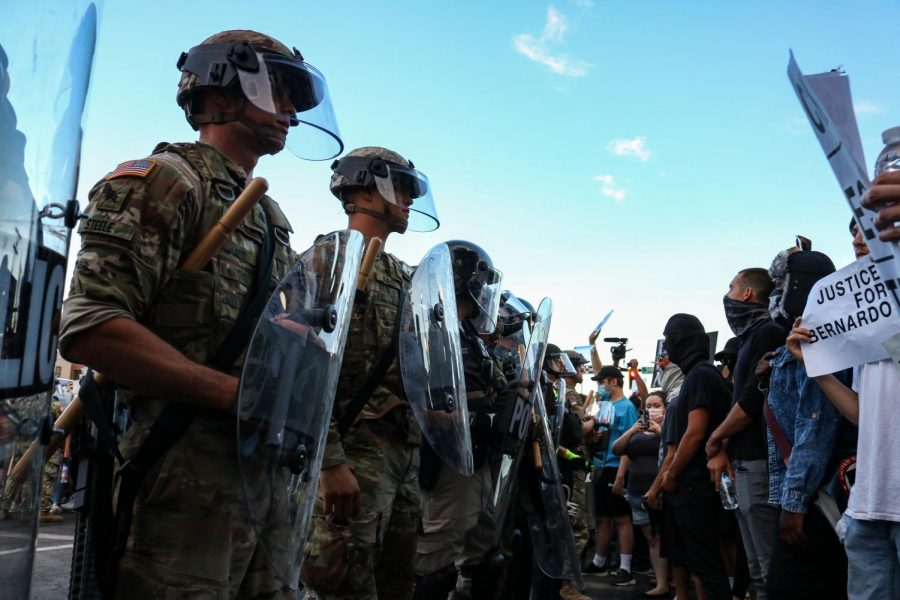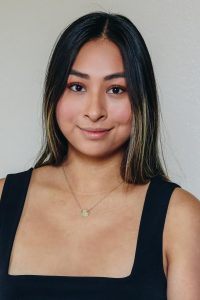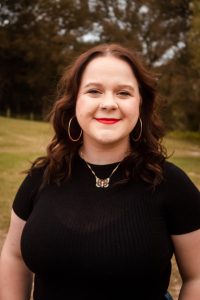An American Summer of Reckoning: Black Lives Matter and Justice for Bernardo
Protesters for the Black Lives Matter movement confront National Guard on 500 S. 200 East in Salt Lake City chanting “why are you in riot gear? I don’t see no riot here!”(Photo by Ivana Martinez | The Daily Utah Chronicle)
August 14, 2020
The Tipping Point
He was not the first Black person killed by police, and though it’s been only 43 days since civilians saw George Floyd killed by police which was broadcasted nationally, he has not been the last.
It happened in Minneapolis. It happened in Ferguson. It happened in Louisville. It happened in Cleveland. It happened in Staten Island. It happened in Aurora. And it happened in Salt Lake City.
And it continues to happen everyday in each corner of the United States.
Black people’s lives are reduced to hashtags that start with “justice for,” but rarely result in any accountability from police. According to mapping police violence, from 2013-2019, “99% of killings by police from 2013-2019 have not resulted in officers being charged with a crime.”
Three radical Black organizers — Alicia Garza, Patrisse Cullors, and Opal Tometi — created a Black-centered political will and movement building project called #BlackLivesMatter in 2013.
The organization came as a response to the killing of Trayvon Martin and the acquittal of George Zimmerman who killed Martin that year.
In 2014, the people of Ferguson rioted for 13 days after the killing of Michael Brown by white police officer Darren Wilson calling for justice. In 2020, the people of Minneapolis repeated a similar pattern in support of Floyd, but this time the protests spread like wildfire.
On May 30, Black Lives Matter protests reached the streets of Salt Lake and continued for weeks to come. Protesters chanted, kneeled, sung, danced, and laid on the hot asphalt streets for eight minutes and 46 seconds to demand justice for victims of police brutality.
The protests were largely led by teens and young adults — organizations such as Party for Socialism and Liberation, Utah Against Police Brutality, Black Hammer, Justice for Bernardo, Covid Mutual Aid and the Rose Park Brown Berets.
Initially the protests in Salt Lake began with a rallying cry for justice for George Floyd, but quickly led to highlighting other individuals who have been victims of police brutality. Lists of names including Breonna Taylor, Eric Garner, Tamir Rice, Darren Hunt, Travon Martin, Tony McDade, Michael Brown and countless more have been read over the course of the protests in Salt Lake.
According to the Washington Post, which has been tracking police shootings since Jan. 1, 2015 — Black people have been shot and killed by police officers at disproportionate rates. They account for less than 13 percent of the U.S. population, but are killed by police at more than twice the rate of white Americans.
Conversations surrounding police violence have become more prominent and weaved into America’s narrative over the course of the last few years. Activist and co-founder of March for Our Lives Daud Mumin believes the tipping point for this movement has come from President Donald Trump exacerbating the wound.
“President Donald Trump has exacerbated our naiveness, our oblivion to these problems right now. Now, it’s everyday Americans that are taking stances, whether it’s the right stance or the wrong stance, but Americans are taking a stance on the issue — when America for so long has been indifferent,” Mumin said.
Mumin said respectability politics and bipartisanship during the Obama administration were a big reason they got nowhere.
“No one was allowed to take a position, no one was allowed, it didn’t become mainstream. And that is what I think the tipping point was, is now this conversation has become mainstream these narratives have become mainstream,” Mumin said.
The narratives of Black men, women and nonbinary people being shot and killed by police and by members of their communities.
The progression of the protests in Salt Lake have shed light on a bigger issue at hand — how systemic racism has and continues to exist within the United States. Black organizers have spoken up at protests, sharing their own personal experiences with racism and calling out systems of injustice.
One protest consisted of hours of personal testimonials from Black people who live in Utah, each sharing unique but shockingly similar experiences of racism, prejudice and a larger issue.
According to Business Insider, the disparities for Black people range in every aspect of life. From wage gaps where the average Black worker earned just 62 percent of what the average white worker made to home loans — where Black mortgage applicants were more likely to be denied loans than aspiring homeowners of other races.
Over the last couple of years the Black Lives Matter movement has been politicized. University of Utah student and activist studying business and software Elvis Amin spoke on the issues this causes for the movement.
“Helping others understand the Black lives matter movement, I think a lot of people who are not Black or people of color, take it as all we’re saying [is] Black lives are more important or better. When really it’s just saying we want to matter as much as you guys,” Amin said, “I think the biggest thing for me is advocating for human rights.”
Amin said he feels like the reason this movement got political is because the country is in a climatic zone when it comes to politics.
During the course of the protests, demonstrators and organizers have been vocal about defunding the Salt Lake police department. During two city council meetings, several protesters called in upward of five hours to express their thoughts on the proposed budget allocation of $84 million towards SLCPD.
Protestors took action by signing petitions, hitting the polls and calling in to representatives. During some of the protests, demonstrators were encouraged to change their political party affiliation to vote in the republican Utah primaries.
Daud Mumin spoke about how the systems put in place have never been in favor of Black women, poor people and non-straight men. He said they cannot be fooled into believing that these systems will start working for them.
“We need to frame voting and electoral work as harm reduction, right? How do we vote to reduce harm against vulnerable communities? How can we put ourselves in a better position to hold people accountable,” Mumin said.
According to the American Civil Liberties Union, voter ID laws, district redraws and felony disinfranciment has kept voting off the table for many.
Mumin said people put in the work following weeks of protesting. He said people come out and are still ignored because politicians are serving the interests of the state not the people. Mumin said the people need to understand the electoralism within itself is a system that perpetuates colonial practices of obedience.
Activism doesn’t stop on the streets or at the polls. As students return to campus, both Amin and Mumin advise having tough conversations around race and the systems that perpetuate injustice for people of color.
Justice for Bernardo
Sofia Alcala did not know Bernardo Palacios-Carbajal personally, but she lived in his neighborhood, walked the same streets as him, and when she heard he was shot 34 times in the back by SLCPD on May 23 — she started putting flowers and candles on 900 South and 300 West where he was killed.
The memorial kept disappearing and Alcala kept putting it back up. She taped posters to the light pole and eventually people began to encourage her to take lead in the movement.
“Here I am, just this 18 year-old woman, I’m just barely coming into myself and people are telling me get on it. You need to lead [the movement] and I’m just like okay, I guess I can try,” Alcala said.
Alcala spoke to Palacios-Carbajal’s family and they told her they wanted to get Bernardo’s name out there. So it began, Alcala and close family friend Lorena Burciaga started showing up to other protests and then hosting their own.
Justice for Bernardo intersected with the Black Lives Matter protests across SLC over the past few months. Alcala worked together with other local organizations with a similar goal — demand justice for those who’ve been killed from police brutality.

They hosted daily protests outside the district attorney Sim Gill’s office which began on June 27. They showed up demanding murder charges for the police officers who killed Palacios-Carbajal.
During the first few weeks following the initial protest on May 30, there was strong police presence in Salt Lake City. Alcala said her main focus is keeping her fellow protesters and those supporting the movement safe.
“You just have to put your emotions in a box and just be like, nope, we came out here … so this is my mentality just going into it like I just did to protect my people that’s always been my mentality,” Alcala said.
Palacios-Carbajal was a member of the Rosepark community in west Salt Lake. Alcala’s message as they protested together was always unity and focusing on the bigger enemy.
“I know we have our issues, but look at what they’re doing to our people,” Alcala said, “because regardless of your affiliation, regardless of your family, regardless of your faith. They’re still coming after you. They don’t care.”
In planning, Alcala said their target is always Sim Gill, because he would be the one with power to give the officers murder charges.
“Sim Gill specifically we’re watching you. You know what we want. And we know that you can give it to us. Just put them in jail,” Alcala said.
On July 9, Sim Gills announced the officers involved in the killing of Bernardo Palacios-Carbajal would not face charges. The decision resulted in anger and unrest from protesters.
A protest ensued later that evening where the district attorney’s office and the street were covered in red paint to illustrate the “blood on Gill’s hands.” Protesters were surrounded by riot police who rammed into the group, arrested four people. The SLCPD declared that night they would not allow people to block traffic as a means of protest anymore. Gov. Gary Herbert announced a state of emergency that evening restricting access to the capitol.
“They are angry at us because we destroy their property. We are angry at them because they kill our people,” said Alcala at the protest the day Gill released his decision.
Alcala plans to attend the U in the fall and major in social work. While she has planned dozens of small protests in front of the district attorney’s office and a few larger ones where they’ve marched all over Salt Lake City, she does not consider herself an activist.
“When I see something that I feel like is wrong, or that I feel like morally needs to be corrected it’s just something like my heart just goes out to it and suddenly I adopt it as if it’s my own cause. I adopt it as if it’s personal for me because it is personal,” Alcala said.
While Alcala was one of the voices of the movement, the queer-led, volunteer-based artists Local Propagandists have mass produced many of the posters that protesters held in the streets.
The group formed on the first day of Salt Lake protests on May 30, and were present at almost every protest. The anonymous group has six core members but 23 people who regularly volunteer to help them hand screen print posters, for some it’s a full time job.
“We’re just labeling ourselves as a direct action screen printing shop to provide free posters for protesters. So it’s essentially just amplifying the protesters’ voice,” said an anonymous representative from the group.
When creating different art and posters, they are often contacted by families or organizations seeking justice, and talk to them about their message or what they want to portray, then they will work with them to create the art and posters and plaster them across the city.
“There’s a lot of movements for a lot of different people, a lot of different issues. So we try to tackle every single one of those issues for people, and at least provide a couple thousand [posters] of each for each person that is needing their voice amplified,” they said.
The organization is completely donation based and they give all posters and t-shirts out for free.
A common tactic of Justice for Bernardo is covering the district attorney’s office windows with the Local Propagandists posters reading “justice for Bernardo,” “Black Lives Matter,” “Abolish racist gangs with badges,” and “Mayor, what happened to his fingers?”
When the posters are removed, people often show up with more the next day and put more up.
At the beginning of July they had printed over 37,000 posters, providing even more as the month progressed, all made by hand, sometimes working 14 to 17 hours a day.
Despite the summer nearing its end and many protesters heading back to school, Local Propagandists plan to continue to help amplify different movements with their talents and art.
“People may not be able to march in the streets every day but people are gonna probably, give a headache to like the people that run the campus, the administration, and that’s much more feasible for these students,” they said.
Their work extends beyond just printing and showing up to protests. Local Propagandists puts together art kits for children living in Salt Lake, helps train others in screen printing, and provides general support to the many movements they are passionate about.
The group believes art and activism go hand in hand, that creativity is essential to the revolution and the people. One of their rallying quotes is, “The role of the artist is to make the revolution irresistible,” from Toni Cade Bambara.









